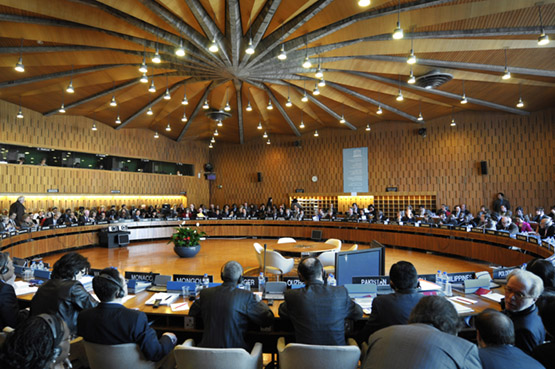Archive Groups
UNESCO's archives are, for practical reasons, organized in 16 Archive Groups (AG):
AG 1: International Institute of Intellectual Co-operation (IICI) 1925-1946, Paris
AG 2: Conference of Allied Ministers of Education (CAME) 1942-1945, London
AG 3: UNESCO Preparatory Commission (Prep. Com.) 1945-1946, London, Paris
AG 4: General Conference Documents (C) 1945-
AG 5: Executive Board Documents (EX) 1946-
AG 6: Secretariat Documents (S) 1946-
AG 8: Secretariat Records 1946-
AG 9: Archives of Field Units, Institutes and Centres
AG 10: Archives of Staff Associations
AG 11: Microcopies
AG 12: Audiovisual Archives
AG 13: Archives of Colour Reproductions of Paintings
AG 14: Publications, documents and records on UNESCO
AG 15: Archives and Documentation of International Organizations
AG 16: Electronic Records
For all information concerning the content of the fonds and the major inventories, which are available online and on-site, please consult the UNESCO Archives Catalogue (AtoM). Please note that the UNESCO Archives Catalogue is still under construction. For the moment, general descriptions of the sixteen fonds and of a few collections are available. Further information is continuously added.
Research in the Fonds
Research in the UNESCO Archives could start with identifying official documents and possibly publications relating to the subject:
- Therefore, a study of a specific matter could begin with the relevant General Conference and Executive Board documents (AG 4) and (AG 5);
- Searches in UNESCO’s Documentary Database (UNESDOC) are indispensable to identify documents and publications on the subject;
- The list of research works on UNESCO history, deposited in the Archives, would also prove useful;
- Furthermore, monographs and articles on the issue should be checked (AG 7) and (AG 14);
- Before 1972, card indexes must be used as a complement to the database (AG 6 and AG 7);
- For records older than 20 years, programme files should then be examined (AG 8);
- In some cases the archives of field units (AG 9) or audiovisual archives (AG 12) could bring additional valuable information or approaches.
If the research is focused on an important person in the life of UNESCO, for example a Director-General, the correspondence files and possibly some administrative files (AG 8) will normally be the most important sources. But they should be combined with Secretariat documents (AG 6) such as mission reports and lists of members of the Secretariat.
As a general rule for research in the UNESCO Archives it is recommended to combine the sources and to check all Archive Groups that could reasonably be expected to include relevant information. The Organization's history, orientations and activities are reflected in a wide range of different series and sources, including private, public and international archival collections outside the custody of the UNESCO Archives.
Arrangement
The filing plan used for programme sector files of the Secretariat (1946-1996) is mainly based on the Universal Decimal Classification (UDC) system. The UDC structures information and files according to subject words in a codification system developed as a cataloguing tool for libraries. Since 1996, most programme sector files are organised according to decentralized filing plans, which reflect the provenance of the records. By contrast, the inventories of archives originating in the central and administrative services have respected the traditional, archival provenance principle since the establishment of the Secretariat in 1946.

